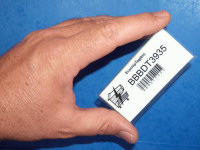 Trolley Scan (Pty) Ltd, a Johannesburg, South Africa based developer of RFID (Radio Frequency Identification) technologies announced the delivery of the first commercialised version of an amazing new RFID technology that they have trademarked "RFID-radar". The first clients are an IT company based in Europe.
Trolley Scan (Pty) Ltd, a Johannesburg, South Africa based developer of RFID (Radio Frequency Identification) technologies announced the delivery of the first commercialised version of an amazing new RFID technology that they have trademarked "RFID-radar". The first clients are an IT company based in Europe.
Said Mike Marsh, Managing Director of Trolley Scan -"The delivery of the first RFID-radar system to our client in Europe, marks the end of a hectic six months of development. Just six months ago we stumbled by chance on a method of measuring the distance, with great accuracy and over long distances, that a signal travelled from a transponder back to a reader. We have had to build concept proving equipment, conduct extensive field tests and design the first version of the commercial equipment.
 The testing included 14000 range measurements to verify consistency and accuracy. The system contains four parallel computers to perform the massive numerical calculations for which we had to write and debug thousands of lines of code. In addition we had to write handbooks for the operators. This delivery marks a milestone in the development of this exciting technology".
The testing included 14000 range measurements to verify consistency and accuracy. The system contains four parallel computers to perform the massive numerical calculations for which we had to write and debug thousands of lines of code. In addition we had to write handbooks for the operators. This delivery marks a milestone in the development of this exciting technology".
"The breakthrough with RFID-radar is the ability to measure the distance travelled by a signal from a transponder to a reader accurately, using minimal radio spectrum to reduce effects on other users, and with very low cost transponders and readers. This invention allows us to develop a new generation of RFID reader, a reader that can identify and locate exactly many transponders in a very large reading zone."
Said Marsh- "The new technology will result in the development of an entire new set of applications for computer based equipment. Applications could include the location of goods in a warehouse; tracking of individual animals in a herd; the monitoring of the movement of assets in a building; the location of parcels and airline luggage in a warehouse; the monitoring of children in a creche; or the monitoring of security zones to ensure sensitive areas are avoided. As all measurements are performed from one set of antennas, the equipment can even be mounted on a forklift truck to locate goods in a warehouse relative to the current position of the vehicle."
 The commercialisation will promote the development of longer range RFID systems, using lower power passive transponder technology. The delivered system operates in the EU RFID band at 869.5MHz with very low power. Due to the wideband nature of the transponders, and the flexibility of the reader, the system can be set to operate at any of the UHF frequencies in the 860-960 MHz bands, making it suitable for use in all countries. Currently operating ranges of 40 meters are practical, but it is expected to extend this to 100 meters in the near future.
The commercialisation will promote the development of longer range RFID systems, using lower power passive transponder technology. The delivered system operates in the EU RFID band at 869.5MHz with very low power. Due to the wideband nature of the transponders, and the flexibility of the reader, the system can be set to operate at any of the UHF frequencies in the 860-960 MHz bands, making it suitable for use in all countries. Currently operating ranges of 40 meters are practical, but it is expected to extend this to 100 meters in the near future.
In the future there will be RFID readers that just give identity information, and there will be RFID-radar type readers that give identity, location and tracking information.

Add a Comment
No messages on this article yet